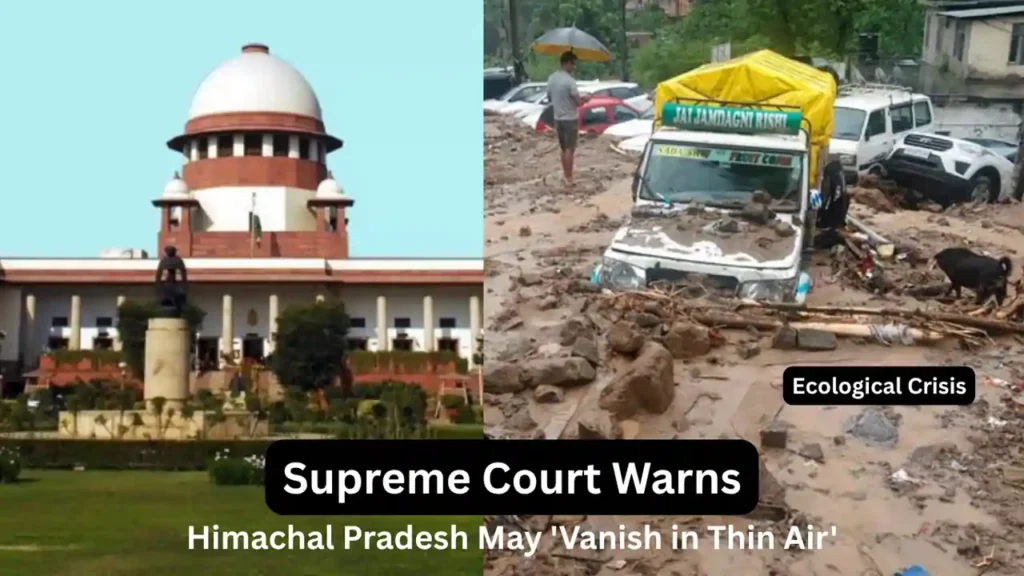New Delhi: In a stark warning, the Supreme Court of India has raised serious concerns about the deteriorating ecological balance in Himachal Pradesh, cautioning that the state could “vanish in thin air” if unchecked development continues. The apex court’s observations, made on July 28, 2025, came during a hearing of a Special Leave Petition challenging a Himachal Pradesh government notification prohibiting private construction in areas designated as “green areas.” The court upheld the state’s decision, emphasizing that revenue generation must not come at the cost of the environment and ecology.

Supreme Court’s Dire Warning: Himachal Pradesh at Risk
The Supreme Court bench, comprising Justices J B Pardiwala and R Mahadevan, expressed alarm over the worsening ecological situation in Himachal Pradesh. “The situation in the state of Himachal Pradesh has gone from bad to worse,” the bench stated. “If things proceed the way they are as on date, the day is not far when the entire state of HP may vanish in thin air from the map of the country. God forbid this doesn’t happen.”
The court’s strongly worded remarks were made while dismissing a plea challenging the Himachal Pradesh High Court’s order, which upheld the state government’s June 2025 notification declaring certain areas as “green areas” to curb construction activities. The bench underscored that the notification’s primary aim was to protect the state’s fragile ecosystem from further degradation.
“We want to impress upon the state government and Union of India that earning revenue is not everything. Revenue cannot be earned at the cost of environment and ecology,” the court declared, urging both the central and state governments to prioritize ecological sustainability over short-term economic gains.
Human Activities, Not Nature, to Blame
The Supreme Court firmly rejected the notion that natural disasters in Himachal Pradesh, such as landslides, land subsidence, and collapsing infrastructure, are solely the result of natural phenomena. “It is not right to blame only nature for the disaster in Himachal Pradesh. Humans, not nature, are responsible for phenomena such as continuous land sliding of mountains and soil, landslides on roads, collapsing of houses and buildings, subsidence of roads, etc.,” the bench asserted.
The court identified several human-driven activities as the primary causes of environmental degradation in the state. These include unchecked infrastructure development, such as hydropower projects, four-lane highways, multi-storey buildings, and deforestation. The bench noted that these projects, often undertaken without adequate environmental planning, have significantly increased the region’s vulnerability to natural disasters.
Key Environmental Challenges in Himachal Pradesh
The Supreme Court highlighted several critical issues contributing to the ecological crisis in Himachal Pradesh:
1. Infrastructure Development and Tourism
Himachal Pradesh, renowned for its scenic beauty and greenery, has seen a rapid increase in infrastructure projects driven by the twin goals of connectivity and tourism. The construction of four-lane highways, ropeways, tunnels, and urban expansions has often bypassed environmental safeguards, leading to destabilized slopes and increased susceptibility to landslides. The court noted that the state’s natural beauty, with forests covering over 66% of its land area, is under threat due to “human greed and apathy.”
Tourism, a major economic driver, has further strained the state’s fragile ecosystem. The uncontrolled growth of tourism, particularly nature and religious tourism, has led to environmental degradation, with the court warning that “if left unchecked, the pressure from tourism could severely undermine the ecological and social fabric of the state.”
2. Hydropower Expansion
Himachal Pradesh is often referred to as India’s “power state” due to its significant hydropower potential. While hydropower is a renewable and low-carbon energy source, the court emphasized its considerable environmental costs. Large-scale construction of dams, reservoirs, and tunnels has disrupted aquatic ecosystems, with rivers like the Sutlej reduced to mere rivulets. The environmental impact of hydropower projects has been profound, contributing to soil erosion and weakened ecological stability.
3. Increased Vulnerability to Disasters
The court pointed to specific instances of natural disasters in Himachal Pradesh, such as those in Kullu (2025), Mandi (2025), and Shimla (2023), as evidence of the state’s growing vulnerability. Unchecked construction and deforestation have weakened soil structures, making the region more prone to landslides, road collapses, and other calamities.
4. Glacier Retreat
The retreat of glaciers, such as the Bara Shigri glacier in Lahaul Spiti, which has receded by 2–2.5 kilometers, is another alarming consequence of climate change and human activities. The court noted that rising temperatures and shifting snowfall patterns are exacerbating environmental challenges, threatening the livelihoods of communities dependent on farming, horticulture, and eco-tourism.
5. Legislative and Administrative Bottlenecks
The Supreme Court also highlighted legislative and administrative shortcomings that have compounded the crisis. Municipal waste management laws are not aligned with the Waste Management Rules 2016, leading to inefficiencies in waste collection and disposal. Additionally, the removal of forest guard check posts has facilitated illegal tree felling, further accelerating deforestation.
Climate Change: A Growing Threat
The court underscored the visible and alarming impact of climate change on Himachal Pradesh. Rising average temperatures, shifting snowfall patterns, and an increase in the frequency and intensity of extreme weather events are threatening the state’s environment and economy. These changes have far-reaching implications for agriculture, horticulture, and eco-tourism, which are vital to the livelihoods of local communities.
The bench also flagged other contributing factors, such as forest fires, encroachments, overgrazing, and the expansion of agricultural and urban areas, as significant drivers of environmental degradation.
Supreme Court’s Call to Action
The Supreme Court emphasized that both the central and Himachal Pradesh governments bear responsibility for addressing the ecological crisis. “The Centre also owes an obligation to see that ecological imbalance in the state does not get further disturbed and natural calamities do not occur,” the bench stated.
To ensure meaningful action, the court directed the Supreme Court registry to register the matter as a public interest writ petition. It also instructed the Himachal Pradesh government to submit a detailed reply outlining whether it has an action plan to address the crisis and what steps it proposes for the future. The matter is scheduled for further hearing on August 25, 2025, pending approval from the Chief Justice of India.
Recommendations for Sustainable Development
The Supreme Court and the provided document outlined several strategies for mitigating the ecological crisis in Himachal Pradesh:
1. Proper Monitoring and Government Accountability
The court called for stringent monitoring to prevent the misuse of green tax funds, which are levied on districts with special status but often diverted for unrelated purposes. Ensuring accountability in the allocation and use of these funds is critical for effective environmental conservation.
2. Addressing Illicit Operations
Illegal activities such as mining and quarrying must be curbed through stricter enforcement of environmental regulations and by providing alternative income sources for communities engaged in these practices.
3. Expert and Community Involvement
The court stressed the importance of consulting geologists, environmental experts, and local communities before initiating development projects in the ecologically sensitive Himalayan region. This collaborative approach ensures that projects are sustainable and aligned with regional challenges.
4. Sustainable Solid Waste Management
To address waste management issues, the court advocated for localized segregation, community awareness, and decentralized processing. Aligning municipal laws with the Waste Management Rules 2016 is essential for effective waste management.
5. Regional Collaboration
The bench suggested that all Himalayan states should pool resources and expertise to develop plans that account for the region’s unique environmental challenges. This collaborative approach could serve as a model for sustainable development across the Himalayan belt.
The Path Forward
The Supreme Court’s observations serve as a wake-up call for both the Himachal Pradesh government and the central government to act swiftly to preserve the state’s ecological balance. The court’s decision to register the matter as a public interest writ petition underscores the urgency of the situation. By prioritizing sustainable development, enforcing environmental regulations, and involving local communities and experts, Himachal Pradesh can mitigate the risks posed by unchecked development and climate change.
The bench concluded with a note of cautious optimism, stating, “Of course much damage has been caused, but there is a saying that ‘something is better than nothing.’” With concerted efforts from all stakeholders, there is hope that Himachal Pradesh can preserve its natural beauty and ecological integrity for future generations.
Conclusion
The Supreme Court’s warning that Himachal Pradesh may “vanish in thin air” is a sobering reminder of the consequences of prioritizing revenue over environmental sustainability. The state’s fragile ecosystem, strained by infrastructure development, tourism, and climate change, requires immediate and coordinated action. By implementing the court’s recommendations and fostering regional collaboration, Himachal Pradesh can chart a path toward sustainable development, ensuring that its natural beauty and ecological richness endure.
Frequently Asked Questions (FAQs)
What did the Supreme Court say about the ecological situation in Himachal Pradesh?
The Supreme Court warned that Himachal Pradesh could “vanish in thin air” if the current trajectory of ecological degradation continues. On July 28, 2025, a bench of Justices J B Pardiwala and R Mahadevan emphasized that human activities, such as unchecked infrastructure development, hydropower projects, and deforestation, are primarily responsible for the state’s environmental crisis. The court urged both the state and central governments to prioritize ecological sustainability over revenue generation.
Why is Himachal Pradesh facing an ecological crisis?
The ecological crisis in Himachal Pradesh is driven by multiple factors, including rapid infrastructure development (e.g., four-lane highways, tunnels), hydropower projects that disrupt aquatic ecosystems, deforestation, and uncontrolled tourism. Climate change has exacerbated the situation with rising temperatures, shifting snowfall patterns, and frequent extreme weather events. Additionally, legislative bottlenecks, such as outdated waste management laws, and administrative issues, like the removal of forest guard check posts, have worsened the crisis.
What specific environmental issues were highlighted by the Supreme Court?
The court highlighted several issues:
Illegal Activities: Removal of forest guard check posts has facilitated illegal tree felling, and outdated waste management laws hinder effective waste handling.
Infrastructure and Tourism: Projects like highways and urban expansions destabilize slopes, increasing landslide risks.
- Hydropower Expansion: Large-scale dam and tunnel construction has reduced rivers like the Sutlej to rivulets.
- Disaster Vulnerability: Weakened soil structures have led to disasters in places like Kullu, Mandi (2025), and Shimla (2023).
- Glacier Retreat: The Bara Shigri glacier in Lahaul Spiti has receded by 2–2.5 kilometers.
What solutions did the Supreme Court propose to address the crisis?
The court recommended:
- Proper Monitoring: Ensuring green tax funds are used for environmental purposes.
- Addressing Illegal Operations: Enforcing regulations against illegal mining and quarrying while offering alternative income sources.
- Expert Involvement: Consulting geologists, environmental experts, and local communities before starting development projects.
- Sustainable Waste Management: Implementing localized segregation, community awareness, and decentralized waste processing.
Regional Collaboration: Encouraging Himalayan states to pool resources for sustainable development.
What actions has the Supreme Court taken to address the ecological crisis in Himachal Pradesh?
The Supreme Court upheld the Himachal Pradesh government’s June 2025 notification prohibiting private construction in designated “green areas.” It also directed the court registry to register the matter as a public interest writ petition and asked the state government to submit a detailed action plan to address the crisis. The matter is scheduled for further hearing on August 25, 2025, pending approval from the Chief Justice of India.

